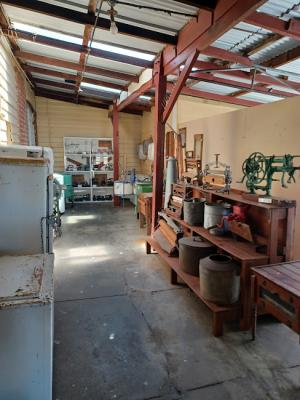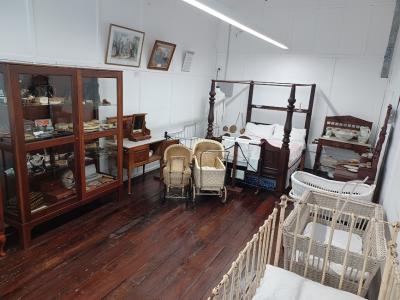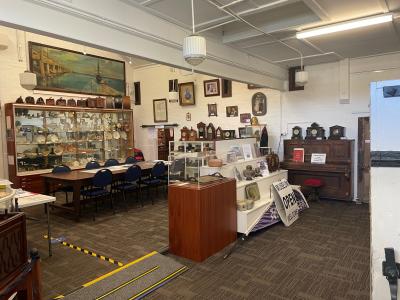Timber Room
1927This room of the Old Butter Factory appears to have been erected in stages, probably linked to extensions of the first-floor area after 1927. The northern section has a lower ceiling height which identifies the footprint of Room 26 above and was probably the first enclosed part of the room. The recessed section on the eastern side of the dropped ceiling is in the same the location as the original 1918 external stair which accessed a landing to the rear of the first-floor rooms. The evidence indicates that the stair was retained in this location when Room 26 was constructed above but removed at a later date.
The original power box and conduits still remain on the eastern wall near the entrance ramp.
This room has been variously known as the Receiving Room, Butter Packing Room and the Pump Room but the Busselton Historical Society now call this the Timber Room as the collection housed in it showcases items associated with the early timber industry in the local Busselton area.
The timber industry in The Vasse started in the 1840’s and was built on logging of old growth tuart and jarrah forests by teams of timber workers. The industry relied principally on man and beast and the use of machines and industrial processes to harvest timber were limited, apart from the mills and the railways, trees were felled by hand in difficult and sometimes dangerous conditions.
The earliest recorded timber milling in The Vasse was conducted in the 1840’s by Charles Keyser when he loaded pit sawn flitches and squared logs onto American whaling ships to be exported to the east coast of America. This timber was shipped from McGibbon’s Jetty, about 5 miles west of Busselton.
The 1850’s saw a number of local settlers applying to the Colonial Secretary for licenses to cut and export timber. This included Henry Yelverton who established the first steam operated timber mill at Quindalup in 1854. This mill employed some convict labour and timber was shipped from the Quindalup jetty.
The 1870’s saw the rise of the Ballarat Timber Company and the WA Timber Company in the vicinity of Wonnerup. A mill and jetty were built in the Wonnerup region and the Lockeville – Yoganup Railway (Ballarat Tramline) was constructed. The Ballarat engine that ran on this line was the first steam locomotive to operate in WA and it transported timber from as far inland as Yoganup to the mill and the jetty.
From the 1870’s timber from inland mills like Barrabup was railed to Busselton for export from the Busselton Jetty and Busselton continued to be a major shipping port of timber until post WW2.
Details
Details
Related Objects
Related Objects
Other items from Busselton Historical Society
Scan this QR code to open this page on your phone ->




